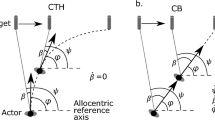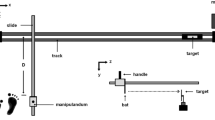Abstract
Behavioral studies suggest that humans intercept moving targets by maintaining a constant bearing angle (CBA). The purely feedback-driven CBA strategy has been contrasted with the strategy of predicting the eventual time and location of the future interception point. This study considers an intermediate anticipatory strategy of moving so as to produce a CBA a short duration into the future. Subjects controlled their speed of self-motion along a linear path through a simulated environment to intercept a moving target. When targets changed speed midway through the trial in Experiment 1, subjects abandoned an ineffective CBA strategy in favor of a strategy of anticipating the most likely change in target speed. In Experiment 2, targets followed paths of varying curvature. Behavior was inconsistent with both the CBA and the purely predictive strategy. To investigate the intermediate anticipatory strategy, human performance was compared with a model of interceptive behavior that, at each time-step t, produced the velocity adjustment that would minimize the change in bearing angle at time t + ∆t, taking into account the target’s behavior during that interval. Values of ∆t at which the model best fit the human data for practiced subjects varied between 0.5 and 3.5 s, suggesting that actors adopt an anticipatory strategy to keep the bearing angle constant a short time into the future.










Similar content being viewed by others
Notes
Fajen and Warren (2007) presented simulations to show that the bearing angle whose change must be nulled is defined in an exocentric reference frame. When simulated agents keep the target at a constant egocentric (rather than exocentric) direction, the resulting trajectory spirals behind the moving target for some initial conditions. By comparison, human subjects follow a straight path ahead of the target (Fajen and Warren 2004).
Although it is common to apply Bonferroni tests and thus to decrease alpha to compensate for the greater family-wise probability of a type 1 error when performing multiple t tests, our strategy of maintaining an alpha of 0.05 was the more conservative approach in that it increased the odds of rejecting the null hypothesis when we should not have rejected it.
For each combination of radius/direction, initial target speed, and target approach angle, the model was then used to produce one simulated speed profile for each possible combination of ∆t, β, and ω 0.
References
Bastin J, Montagne G (2005) The perceptual support of goal-directed displacement is context-dependent. Neurosci Lett 376:121–126
Bastin J, Craig C, Montagne G (2006) Prospective strategies underlie the control of interceptive actions. Hum Mov Sci 25:718–732
Chapman S (1968) Catching a baseball. Am J Phys 36:368–370
Chardenon A, Montagne G, Laurent M, Bootsma RJ (2005) A robust solution for dealing with environmental changes in intercepting moving balls. J Mot Behav 37:52–64
Cutting JE, Vishton PM, Braren PA (1995) How we avoid collisions with stationary and moving obstacles. Psychol Rev 102:627–651
de Lussanet MH, Smeets JB, Brenner E (2001) The effect of expectations on hitting moving targets: influence of the preceding target’s speed. Exp Brain Res 137:246–248
de Lussanet MH, Smeets JB, Brenner E (2002) The relation between task history and movement strategy. Behav Brain Res 129:51–59
Fajen BR, Warren WH (2004) Visual guidance of intercepting a moving target on foot. Perception 33:675–689
Fajen B, Warren W (2007) Behavioral dynamics of intercepting a moving target. Exp Brain Res 180:303–319
Jordan MI, Wolpert DM (1999) Computational motor control. In: Gazzagina M (ed) The cognitive neurosciences. MIT Press, Cambridge, MA, pp 601–620
Lanchester BS, Mark RF (1975) Pursuit and prediction in the tracking of moving food by a teleost fish (Acanthaluteres spilomelanurus). J Exp Biol 63:627–645
Le Brun D (2002) Nouveau manuel du marin [New Seaman’s manual]. Solar, Paris, France
Lenoir M, Musch E, Janssens M, Thiery E, Uyttenhove J (1999a) Intercepting moving objects during self-motion. J Motor Behav 31:55–67
Lenoir M, Savelsbergh GJ, Musch E, Thiery E, Uyttenhove J, Janssens M (1999b) Intercepting moving objects during self-motion: effects of environmental changes. Res Q Exerc Sport 70:349–360
Lenoir M, Musch E, Thiery E, Savelsbergh GJ (2002) Rate of change of angular bearing as the relevant property in a horizontal interception task during locomotion. J Mot Behav 34:385–404
McLeod P, Reed N, Dienes Z (2006) The generalized optic acceleration cancellation theory of catching. J Exp Psychol Hum Percept Perform 32:139–148
Montagne G (2005) Prospective control in sport. Int J Sport Psychol 36:127–150
Olberg RM, Worthington AH, Venator KR (2000) Prey pursuit and interception in dragonflies. J Comp Physiol [A] 186:155–162
Warren WH (1998) Visually controlled locomotion: 40 years later. Ecol Psychol 10:177–219
Acknowledgment
This research was supported by grants from the National Science Foundation (BCS 0545141 and BCS 0236734)
Author information
Authors and Affiliations
Corresponding author
Rights and permissions
About this article
Cite this article
Diaz, G.J., Phillips, F. & Fajen, B.R. Intercepting moving targets: a little foresight helps a lot. Exp Brain Res 195, 345–360 (2009). https://doi.org/10.1007/s00221-009-1794-5
Received:
Accepted:
Published:
Issue Date:
DOI: https://doi.org/10.1007/s00221-009-1794-5




